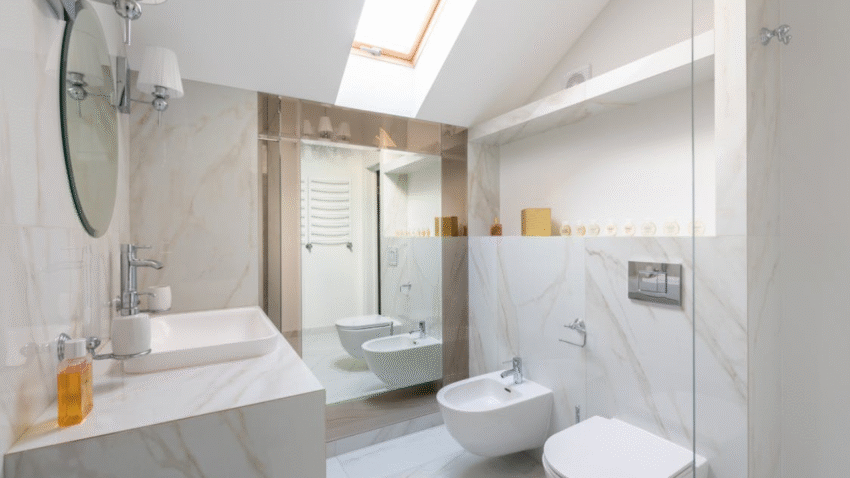Introduction
Sick of walking into your bathroom only to be hit by lingering odors? You’re not alone. This guide on how to eliminate odors in the bathroom will show you exactly how to tackle unpleasant smells at the source—and keep them from coming back. Whether it’s a musty scent, sewer smell, or just daily use funk, you’ll learn how to freshen your space the right way.
Why Eliminating Bathroom Odors Matters
Bad bathroom odors are more than just embarrassing—they can be signs of deeper issues like poor ventilation, plumbing problems, or hidden mold. Constant smells can affect indoor air quality, make guests uncomfortable, and even impact your well-being.
A fresh-smelling bathroom improves your home environment, makes cleaning feel more rewarding, and contributes to a calm, spa-like space. Eliminating odors is key for comfort, hygiene, and creating a welcoming atmosphere. Plus, it helps preserve the integrity of your fixtures and prevent buildup in drains, toilets, and vents.
Step-by-Step Guide to Eliminating Bathroom Odors
Step 1: Identify the Source
Don’t just mask the smell—find it. Common odor sources include:
- The toilet (under the seat, around the base)
- The sink or shower drain
- Mold or mildew on walls and tile
- Damp towels or bathmats
- Poor ventilation or clogged exhaust fans
Pinpointing the smell allows you to treat it at the root, not just cover it with air fresheners.
Step 2: Clean the Toilet Thoroughly
Use a toilet bowl cleaner and toilet brush to scrub under the rim and inside the bowl. Don’t forget to:
- Wipe the base of the toilet with disinfectant
- Clean behind the tank and under the seat
- Replace or wash the toilet seat if it’s stained or retains odors
💡 Add a few drops of essential oil to the inside of the toilet paper roll for a constant fresh scent.
Step 3: Deep Clean Drains
Sink and shower drains often harbor trapped hair, soap scum, and bacteria, which can emit a sulfur-like or musty smell.
- Pour boiling water down the drain
- Follow with a ½ cup of baking soda and a ½ cup of vinegar
- Let sit for 10–15 minutes, then flush with more hot water
Consider using a drain snake to remove deep clogs and buildup.
Step 4: Improve Ventilation
Odors linger in bathrooms without proper airflow. Clean your exhaust fan and make sure it works efficiently. If your bathroom has a window, open it during and after showers.
- Install a humidity-sensing exhaust fan if your current one is weak
- Leave the fan running for 20–30 minutes after using the bathroom
- Use a small dehumidifier if your bathroom tends to stay damp
Step 5: Wash All Fabrics
Smells cling to soft items like towels, rugs, curtains, and even shower curtains. Wash everything in hot water with white vinegar or baking soda to eliminate odor-causing bacteria.
🧺 Don’t forget to clean or replace the bathmat—it’s often the stinkiest item in the room!
Step 6: Clean Hidden Areas
Don’t overlook:
- Behind the toilet
- Under the sink
- Inside cabinets (especially if you store damp items)
- Corners of the shower or tub where mold may grow
Use a mildew-resistant spray and microfiber cloth to scrub these areas.
Step 7: Use Natural Deodorizers
Avoid masking smells with heavy chemical sprays. Instead, use:
- Activated charcoal: Place a bowl behind the toilet to absorb odors
- Baking soda: Leave an open container on a shelf or behind a fixture
- Essential oil diffusers: Lavender, eucalyptus, or tea tree oil work great
- Houseplants: Some like aloe vera or spider plants purify air naturally
Step 8: Seal Gaps and Cracks
If odors persist, inspect for cracks in caulking, baseboards, or tile grout. These can harbor mold or allow sewer gases in.
- Re-caulk around the toilet base and bathtub if needed
- Seal gaps in tile with grout sealer
- Check for leaky pipes or damp spots that may be causing mold
Common Mistakes to Avoid
Mistake 1: Using Only Air Fresheners
Air sprays only cover up bad smells—and can make them worse over time.
Solution: Always clean the source of the smell before using any fragrance-based solution.
Mistake 2: Ignoring the Drain
Many people focus on the toilet but forget about the drains, which can trap bacteria and create a rotten egg smell.
Solution: Clean the drains regularly using baking soda and vinegar or enzyme cleaners.
Mistake 3: Letting Towels Sit Damp
Leaving wet towels hanging can fill the room with a musty, sour smell.
Solution: Wash towels frequently and make sure they dry fully between uses.
Mistake 4: Not Cleaning the Exhaust Fan
A dusty, clogged fan can’t do its job properly.
Solution: Remove the fan cover and clean it every few months to maintain good airflow.
Mistake 5: Keeping the Lid Up
When you flush with the toilet lid up, particles can spread and settle throughout the bathroom.
Solution: Always close the lid before flushing to contain odors and bacteria.
Extra Tips & Bathroom Hacks
- DIY toilet fizz bombs: Mix baking soda, citric acid, and essential oil in a mold and drop one in the toilet daily to neutralize odor.
- Use a motion-sensor diffuser: These automatically release scent only when someone enters the room, keeping it fresh without overpowering it.
- Swap to odor-resistant towels: Bamboo or microfiber towels resist bacteria and dry faster than cotton.
🧼 Also check out our guide on how to disinfect a bathroom sink to keep every area smelling clean and germ-free.
Conclusion
Eliminating bathroom odors isn’t just about scents—it’s about identifying the source, deep cleaning hidden trouble spots, and making smart upgrades to prevent smells from coming back. From scrubbing drains to using natural deodorizers and improving airflow, each step creates a cleaner, fresher bathroom.
✅ Start small and stay consistent. A fresh-smelling bathroom is just a few smart habits away.
Bookmark this guide to keep bad odors at bay all year round.
